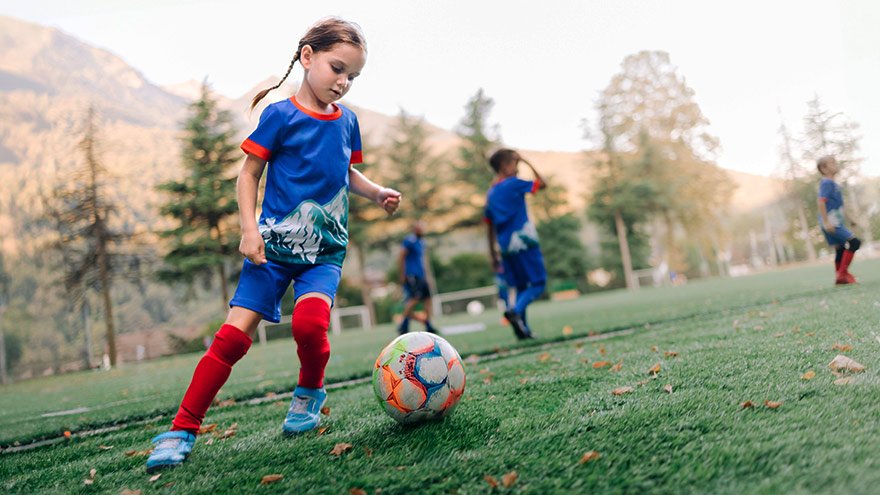
Head Injuries, Sprains and Broken Bones

Back-to-school season means kids and teens are gearing up for sports and physical activities — which are both enjoyable and beneficial for our health. However, with the fun and excitement of sports comes the risk of injuries. Sprains, traumatic brain injuries, and broken bones are more common than we realize and can sometimes lead to an emergency room visit.
Dr. Scott Shepherd, Emergency Medicine Physician, shares important information to help keep athletes safe.
Traumatic Brain Injuries: The Invisible Threat
Traumatic brain injuries come in many forms. From “mild” brain injuries, concussions, to major brain injuries and bleeds. Sometimes it is very difficult to tell the difference between a major injury and a minor injury because many of the symptoms are the same.
Concussions
Concussions are a type of “mild” traumatic brain injury resulting from a blow to the head or a violent shaking of the body that causes a transient alteration in mental function. They are particularly prevalent in contact sports such as football, soccer and boxing. A concussion can affect memory, judgment, reflexes, speech, balance and muscle coordination. Typically, concussions are not life threatening and usually short lived. However, multiple concussions can lead to permanent disabilities. So, remember there is nothing “mild” about injuring your brain.
Contusions
The more serious brain injuries from brain contusions (actual bleeding in the brain material) and bleeding that presses on the brain are life threatening. These injuries are caused by the same blow to the head as a concussion and the symptoms are the same from memory deficits, loss of coordination to coma. Because of this, anyone who has a blow to the head and is not acting normal should be evaluated by a medical professional.
Anyone suspected of having a severe head injury should seek immediate medical attention and follow a strict protocol for rest and a gradual return to play. It is important to note a person may not lose consciousness if they suffer a concussion; however, major consequences can occur if not properly managed.
If you suspect you have an emergency that needs immediate medical attention, please call 911 or visit an emergency room near you.
While it is impossible to prevent traumatic brain injuries altogether, the severity of the injury can be mitigated through proper helmet usage and knowing your skill level when participating in high-risk activities.
The guidelines for picking a helmet for summer activities such as mountain biking, dirt biking and riding off highway vehicles are similar to those of picking a helmet for winter sports. Learn more about choosing the right helmet.
Any blow to your head, neck or upper body can result in a major head injury
Signs to watch for include the following:
- Headache
- Dizziness
- Blurred vision
- Difficulty with thinking, attention or memory
- Sensitivity to noise or light
- Ringing in the ears
- Changes in hearing
- Double vision
- Changes in behavior
- Balance issues
- Nausea/vomiting
Sprains: The Annoying Twist
One of the most common sports injuries is a sprain, which occurs when ligaments that connect bones are stretched or torn. Sprains typically occur in joints, such as the ankle, knee or wrist, and are often caused by sudden twists or impacts.
Symptoms may include:
- Pain Swelling
- Bruising
- Limited range of motion
Rest, ice, compression and elevation (RICE) are the initial recommended treatment, followed by physical therapy to regain strength and mobility.
Trauma & Emergency Care

Broken Bones: The Ultimate Setback
Fractures or broken bones can occur in any sport where a high impact or force is exerted on the body. These injuries range from stress fractures (small cracks caused by overuse) to complete fractures resulting from acute trauma. The symptoms of a broken bone may include:
- Severe pain
- Swelling
- Deformity
- Inability to bear weight or move the affected area
- In more severe cases, treatment may involve immobilization with a cast, splint or surgical intervention
Other Orthopedic Injuries: Beyond the Basics
In addition to sprains, concussions and broken bones, individuals may encounter numerous other orthopedic injuries, such as:
- Muscle strains
- Ligament tears (such as anterior cruciate ligament tears in the knee)
- Tendonitis Dislocations
The treatment for these injuries varies depending on the severity and location of the injury, often involving a combination of rest, physical therapy, medication or surgery.
Play Smart, Stay Safe with These 5 Prevention Strategies
- Warm up and stretch properly before engaging in physical activity to prepare the muscles and joints.
- Wear appropriate protective gear, such as helmets, mouthguards, knee pads and shin guards.
- Follow the game's rules and play within your skill level to avoid unnecessary risks.
- Listen to your body and take breaks when you feel fatigued or in pain to prevent overuse injuries.
- Cross-train and maintain overall fitness to build strength and resilience in different muscle groups.
Related Blogs


Protect Yourself, Your Kids & Others with a Flu Shot
